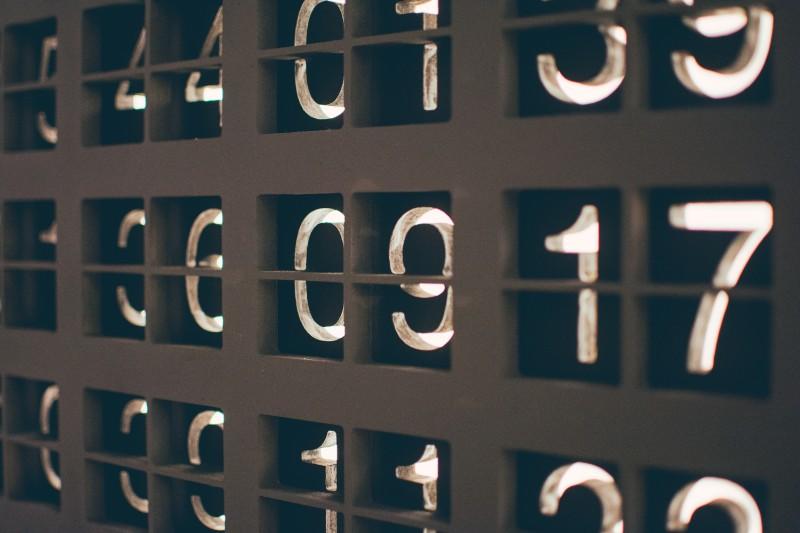Around 1200 AD, the Italian mathematician Fibonacci introduced the concept of zero in Europe. In India, it was initially called 'Sunya', while in the Middle East it was known as 'Sifr' when it reached Italy, where it was named 'Zefero', and later in English it became known as 'Zero'.
History of Zero
Every student in every classroom across the world knows that if they get a zero on their maths homework or on a maths exam they are in big trouble. The Zero, in this case, is synonymous with failure as they were unable to solve problems correctly out of all of the questions that were asked.
But the zero is used in many more places than just the classroom grading system, it is part of our whole society. Prices of things in shops, license plates, numbers to call, numbers in your bank account when you are broke. But all fun aside zero is a significant number that has the meaning of nothing but to us means everything since it is perhaps the most used number in the math curriculum.
But when reading the number zero not many people think about its history or about the mathematician who introduced the number to modern mathematics.
Brahmagupta was the first to demonstrate that zero can be reached through calculation. He introduced negative numbers, which he called "debts", and developed rules for calculations involving zero and negative numbers, including addition, subtraction, multiplication, and division. His work on the properties of zero and negative numbers laid the foundation for modern mathematics.
To become fluent in the language of mathematics you have to delve deeper than the surface. Math concepts like algebra, geometry, complex numbers, Pythagorean theorem, Linear equations, probability, Pi, special number Euler's e, trigonometry (trig.), Equivalent fractions, the special number i, the golden ratio, and must be part of your math learning in your grade level math education. Let's start by taking a closer look at the number 0.


History Of Zero - Who Invented Zero?
Brahmagupta, an Indian astronomer and mathematician, utilized zero in mathematical operations such as addition and subtraction. Aryabhatta introduced zero in the 5th century, while Brahmagupta incorporated zero into calculations around 628 AD. Therefore, Aryabhatta is credited with the invention of zero.
The Mayans and Babylonians initially used zero as a placeholder to distinguish larger numbers from smaller ones, but it was Aryabhata, an Indian mathematician and astronomer in the 5th century, who established zero as a digit in its own right.
Aryabhata also contributed other important mathematical concepts, such as the value of pi being 3.14 and the formula for a right-angled triangle. The lack of zero previously had made simple calculations difficult.
In the 7th century, Brahmagupta developed the earliest known methods for using zero within calculations, treating it as a number for the first time. The use of zero was inscribed on the walls of the Chaturbhuj temple in Gwalior, India, where the numbers 270 and 50 can be seen today, representing the second oldest recorded zeros in history. The city of Gwalior was designed so that the gardens around the temple produced enough flowers each day to create 50 garlands for the temple's employees, and this was inscribed on the walls.
What we now call zero in English, Brahmagupta named “shunya” or “sunya”, the Sanskrit word for emptiness or nothingness.
Sumerian Culture in Mesopotamia (Approximately 5,000 years ago)
The first evidence of zero comes from the Sumerian culture in Mesopotamia. About 5,000 years ago, the Sumerians used a slanted double wedge as a placeholder to indicate the absence of a number in a particular place. This concept was essential in their positional number system
Babylonian Empire (Approximately 4,000 to 5,000 years ago)
In the Babylonian Empire, which existed approximately 4,000 to 5,000 years ago, a pair of angled wedges was used to denote an empty number column, serving as a placeholder 7. It allowed for more accurate representation and distinction between numbers.
Maya Civilization (Approximately 2,000 years ago)
The Maya civilization, flourishing around 2,000 years ago in South America, devised a zero marker in their calendars. They used a specific symbol, such as a bowl-like object or a complex face, as a placeholder zero.
India (Approximately 628 CE)
Zero emerged as a distinct number in the Indian civilization. Around 628 CE, Hindu mathematicians began using small dots under numbers to represent zero as a placeholder 3. Moreover, they realized that zero itself represented the absence of a quantity, making it more than just a positional symbol.
Within Indian culture, there is a philosophical concept of a "nothing" or a void within oneself. This idea predates the conception of zero as a numerical digit and is rooted in Hinduism and Buddhism, often practiced through meditation.
The ancient Hindu symbol, the "Bindi" or "Bindu", a circle with a dot in the centre, symbolizes this concept, which may have influenced the development of the oval symbol for the Sunya. This cultural and philosophical foundation on the concept of zero is believed to have enabled India to develop what previous civilizations had not.
The zero originated in India and then traveled to China before returning to the Middle East.
It was adopted by mathematician Mohammed ibn-Musa al-Khowarizmi in 773, who studied Indian arithmetic and incorporated zero into his system of formulas called 'al-jabr', which is now known as algebra. By the 10th century, the zero had become part of the Arabic numeral system in a shape similar to the oval form we currently use.
Strengthen your foundation in numbers with a maths class 10 and master essential mathematical concepts.
Zero In History
The University of Oxford's Bodleian Libraries used carbon dating to trace the origins of the zero symbol to the ancient Indian Bakhshali manuscript, dating back to the third or fourth century, making it the oldest recorded use of the symbol. The manuscript contains hundreds of zeroes, revealing the birth of the concept of zero as a placeholder to represent orders of magnitude in the ancient Indian number system, predating previous scholarly beliefs by 500 years.
The Bakhshali manuscript is widely recognized as the oldest Indian Mathematical text.
The Bakhshali manuscript is an ancient Indian mathematical text written on birch bark, discovered in 1881 in the village of Bakhshali, located near Peshawar, Pakistan. It's known for containing mathematical techniques and concepts, including early forms of arithmetic and algebra.
The manuscript is considered crucial for understanding the history of mathematics in India and shows the advanced mathematical understanding of the time. It is believed to date back to between the 2nd century BCE and the 2nd century CE.
The earliest known use of the zero symbol was previously thought to be a 9th-century inscription in Gwalior, India, but the Bakhshali manuscript predates this, making it historically significant. While other ancient civilizations used zero as a placeholder, the dot in the Bakhshali manuscript is the precursor to the modern zero symbol, and India is where the concept of zero as a number in its own right was developed.
Today the number zero in the numeral system is used to represent the absence of an object or quantity. Each student learns the number 0 from primary school, learning it with the number system for counting, mathematically, with negative numbers and whole numbers.
As we understand it today, the number zero is neither a positive or negative number and as well as being a number it is also a numerical digit. But it was not always like this, zero has developed throughout history and changed with the changing ideas of the culture.
- The ancient Greeks believed that existence began with 1, and anything less than one to be impossible to write due to the fact that it didn’t exist. So the Ancient Greeks had no writing system including zero in their numeral system.
- The Babylonians began using zero to distinguish the void between numbers. So instead of writing 3 5, they added the zero in the middle making 305.
- The Mayans used zero between numbers, to express durations and to mark the dates of the calendar.
- The Indians used zero as if it were any other number and it is from India that the concept of zero was introduced although it took time to be accepted.
- The Arabians adopted the number calling it Sifr and took it to mean emptiness and also infinity.
- The Italians introduced it in Europe by translating it into Latin as Zephirum.
Zero In Ancient History
Mathematics is full of discoveries as found by scholars or mathematicians throughout history. All of these discoveries have allowed us to progress with arithmetic algebra calculus and to develop a theorem to empower new ideas.
In the 5th century zero emerged as a number in its own right. Hindus from India invented zero to represent the idea of the power of the cosmos and universe as they expand into infinity. They called this the sunya which means empty in Sanskrit.
The book Brahma Sphuta Siddhanta was published in c. 628 by Brahmagupta which defines zero as the subtraction of a number by itself, e.g. 5-5 =0. Here is where the journey of zero begins, in India as a concept of nothingness.
In the west, the number zero has negative connotations, you might call someone a zero to mean that they are a loser. But in India, Buddhists and Hindus understand the concept of nothingness to be the attainment of nirvana. This might be why the idea of zero came so naturally to them because this concept is central to their beliefs and further it is something that they are trying to attain.

The International Zero
In the 7th century with the expansion of the Arab culture in the Muslim world. Zero is adopted from the Hindus as a representation of emptiness and infinity. They use the word sifr which means zero in Arabic.
In the 12th century, the zero pops up in Europe and along with that so does Arabic mathematics. But the Catholic church is reluctant and suspicious of the idea of being able to physically write or describe something that means the void, null or the infinite.
In 1200, Leonardo Fibonacci, an Italian mathematician, adopts the Arabic word sifr and translates it into Latin. "zephirum", gradually becomes "zephiro", "zeuero", "cero" (Spanish) and finally, "zero" (Italian) and "zero" in English.

Zero The Evil Number?
Although zero had been prohibited by the churches, they believed zero and the representation of nothingness to be the incarnation of the devil. However, it spread like wildfire through the streets and merchants used it along with decimal numbers.
Maths Worldwide
Liber Abaci, a book on arithmetic is published by Fibonacci who had travelled across Africa, the Middle East, Greece and Egypt to collate all of the mathematical knowledge of the period. These included math concepts and math facts, it was one of the well-recorded textbooks of the era on core standards of maths internationally.
The Different Meanings Of Zero
Zero is not just the point between positive numbers and negative numbers or just the absence of quantity. It is a mathematical symbol which has a philosophical, religious and cultural background.
Indeed it a simple ‘0’ has meant many things to many people including the devil, chaos, emptiness, infinity and nothingness. Today it also represents something free (£0), Infinitesimal (0.00001) or Null (0). It represents the starting point of things or the pause before things begin. Its also symbolism for unity and eternity, the closed circle. However, its links to infinity are separated from the ‘8’ symbol just by the idea that it has so many other meanings and representations.
Here are other meanings attributed to zero
- Renewal or a new beginning, to "start from scratch" and to "reset."
- Security is inferred by it's round and closed shape,
- The idea of fertility, femininity and the fetus can be found in the circle
- Perfection in its shape as each edge is linked to its centre.
- The cycle and regeneration, as the outer edge of zero, leads back to itself.
Zero As Found In Common Expressions
As we have discovered zero is not just a number used to solve math problems or expand your math skills. While it did begin in many cultures as just a number in basic math and algebra. The idea of zero has also permeated common core sayings in English and other languages worldwide.
Expression using the words zero refer to the state of something being missed, missing, non-existent, absent or restarting.
Common Expressions:
- A circle of friends (the unit),
- A vicious cycle, (restarting)
- Have a zero point (bottom),
- Start all over again (reset)
- Start again from the beginning, (reset)
- Zero tolerance,
- Have zero driving skills, (absence)
- zero in my Account, (number)
- A lot of fuss about nothing (absence)
- A blank slate (reset) such as telling time (00:00)
Read more about the other special numbers; Pi or Archimedes constant, the golden ratio or divine proportion, the important prime numbers, and the rare perfect numbers.
Some Mathematical Properties Of Zero
Revising mathematics is impossible without the zero, it is essential in math in either its presence or its concept. But zero in math is not always as apparent as it seems and it can be at the root of some cool math games which can make learning maths much more fun than generally assumed.
Zeros importance in maths is due to it position between the negative numbers and positives numbers( -1, 0, 1), as a number itself (0) and as a marker of the absence of other numbers (10). For such a simple symbol It is very accomplished and has had centuries to develop itself into the position that it holds today.
- It is the smallest natural whole number,
- and it is also a neutral element,
- it is the only number to be both positive and negative at the same time.
- This is the only number that remains unchanged when subtracted or when added to another number (1 + 0 = 1 or 1 – 0 = 1)
- In the multiplication tables, zero is the only number which, when multiplied by any other number, returns the result to a zero quantity.
As a learner, you must learn to recognise how you prefer to learn and which methods give you the best results. High school math, college math and onwards is challenging, it is not basic math like counting, multiplying, dividing, adding or subtraction. The more you the practice the higher the Probability that you will achieve mastery in your mathematics education and curriculum.















